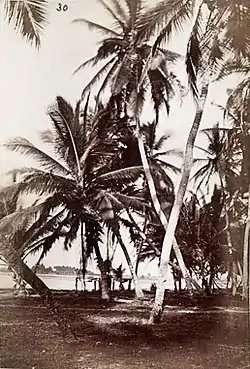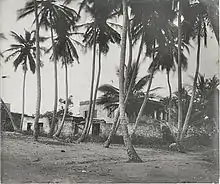Old Ningo
Great Ningo | |
|---|---|
 Old Ningo, 1870s | |
| Country | |
| Region | Greater Accra Region |
Old Ningo is a town in the Greater Accra Region of Ghana.
History
Also known as Great Ningo, the inhabitants have always been a fishing and farming community. They form part of the Ga-Adangbe people. The name Ningo has a much more widely known and accepted history as derived from the Ga–Dangme words nu meaning water and ngoo meaning salt.[1] The "nu" and "ngoo" story rather interesting is not as compelling as evidence which points to a more interesting origin. A publication in the Encyclopædia Metropolitana published in 1817 has this entry."Ningo, near which the second Danish castle, Friedensburg, is placed, is 43 miles from Akra. In Krob6, or Krepe, a large Negro State behind it, there is a very high mountain about 20 or 25 miles distant from the sea, and capped with snow".[2] It gives evidence to a voyager's inspired name as the name Ningo happens to be Latin for snow[3] (Ningo in Latin),[4] and as it goes the mariners would have seen the mountain[5] in the backdrop of the native settlers and named the place Ningo. Many other early writings[6] and references[7] on Ningo also used the term Grande in the form Ningo Grande (grande)[8] translate in Latin as large or great. The name Great Ningo naturally follows. The people of Ningo like to refer themselves as "Nugoli" meaning "People of Nugo" (Nugo being a much more locally accepted pronunciation of the name Ningo) and are proud to associate themselves with the name Great Ningo. The history of the people of Ningo is closely linked to the history of the Ga-Dangme people.
Aboriginal name of Ningo
The original name of people of Ningo is Lasibi.[9] This is part of the 8 groups of people who are identified as Dangme State. Adaa, Nugo, Gbugbla, Kpom, SƐ, Yilô-Klo, Manya-Klo and Osudoku; anglicised as: Ada, Ningo, Prampram, Kpone, Shai, Yilo Krobo, Manya Krobo and Osudoku respectively.

Fort Fredensborg

The Danish were the first European settlers here, establishing the Fort Fredensborg[10] in 1734. The town was developed as a slave trading station as part of Danish Guinea . However, with the abolition of the slave trade the town dwindled in size, with the fort staffed by a single person. The fort was already in ruins when the British took over on 8 March 1850 and incorporated the town into the Gold Coast.[11] Christian Glob Dorf was Commandant from 21 June 1740 to 25 May 1743.[12]
Ningo Clans
Ningo has 4 Divisions and clans under them. First Division:Lower. They hold the paramount chief position and djange wↄnↄ (priest). Clans under LowƐ are:
- Adainya (Djangma We)
- Asere
- We Gobom
- Ohenease (Ohluase)
- Saunya
- Aniamosi
- Ma Momonor
Second Division: Lower Kponↄ They hold the Dzaase/Dzaas-TsƐ Position. Clans under Lowe Kponor are:
- Odoi We (Mantse We)
- Obonu We
- Huago We
- Adela We (Salosi)
- Okubeng We
- Tsawe - Se Agbla-nya
- Osabunya
Third Division: Djangmaku They hold divisional chief position. Clans under Djangmaku are:
- Adade We
- Djange PiƐse
- Saunsi
- Dankyira
- Kabueku
- Suↄ Yi - nya
- Manya Tsu
- Manya Gↄtsonya (Akamisa wem)
Fourth Division: Kabiawe. They hold mankralo position. Clans under Kabiawe are:
- LƐ Wem (Kↄↄley Tso sisi)
- Anarhor
- Alata (Akwadu-tso nya)
- Bantama
- Manya Yum (Mankralo Wem)
Education
The town is also known for the Ningo High and Technical School regarded as having a pleasant environment.[13][14] The school is a second cycle institution.[15]
References
- ↑ "Old Nongo". Ghana Place Names. Ghana Place Names. Retrieved 8 November 2015.
- ↑ Encyclopædia Metropolitana; Or, Universal Dictionary of ..., Volume 20 edited by Edward Smedley, Hugh James Rose, Henry John Rose pg 24
- ↑ "Latin Definitions for: Ningo (Latin Search) - Latin Dictionary and Grammar Resources". latin-dictionary.net.
- ↑ "Latin Definitions for: Ningo (Latin Search) - Latin Dictionary and Grammar Resources". latin-dictionary.net.
- ↑ Retrieved 15/4/2016
- ↑ A Practical Medico-Historical Account of the Western Coast of Africa, etc by James Boyle (Surgeon.) Pg 332
- ↑ The Nautical Magazine, a Journal of Papers on Subjects Connected with Maritime Affairs in General Fisher, Son & Company pg 646
- ↑ "Latin Definitions for: grande (Latin Search) | Latin Dictionary and Grammar Resources". latin-dictionary.net.
- ↑ FIORGBOR, E.T.; TETTEH, K.A.J.E.; NARTEY, M.D (December 2019). "THE EXODUS OF A WEST AFRICAN PEOPLE: DANGME IN ISRAEL'S HISTORY". Journal of Mother-Tongue Biblical Hermeneutics and Theology. 1 (2): 25–42. doi:10.32051/12301903.
- ↑ "Fort Fredenzburg · Unnamed Road, Old Ningo, Ghana". Fort Fredenzburg · Unnamed Road, Old Ningo, Ghana.
- ↑ "Fort Fredensborg, Old Ningo". Ghana Museums and Monuments Board. Ghana Museums and Monuments Board. Retrieved 8 November 2015.
- ↑ Justesen, Ole (2005). Danish Sources for the History of Ghana, 1657-1754: 1657-1735. Copenhagen: Kgl. Danske Videnskabernes Selskab. p. 580. ISBN 9788773043127. Retrieved 8 November 2015.
- ↑ "Educational Institutions". www.centralregion.gov.gh. Retrieved 12 August 2011.
- ↑ "References » Schools/Colleges". www.modernghana.com. Retrieved 12 August 2011.
- ↑ "List of Secondary Schools in Ghana". www.ghanaschoolsnet.com/. Retrieved 12 August 2011.
External links
 Media related to Old Ningo at Wikimedia Commons
Media related to Old Ningo at Wikimedia Commons